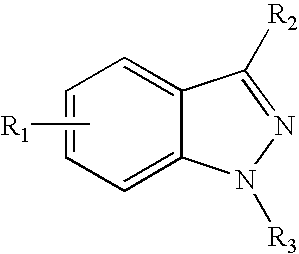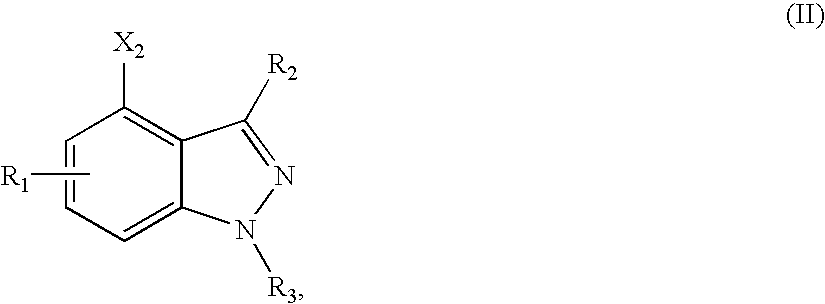Methods for making central nervous system agents that are trpv1 antagonists
a technology of central nervous system and antagonist, applied in the field of compound making, can solve problems such as cell membrane depolarization
- Summary
- Abstract
- Description
- Claims
- Application Information
AI Technical Summary
Problems solved by technology
Method used
Image
Examples
example 1
4-Bromo-1-methylindazole (XXVI)
[0139]A solution of crude 2-bromo-6-fluorobenzaldehyde (42 g, 0.2 mol) (XXV) in DMSO (44 mL) was added to methylhydrazine (63 g, 7 eq) while maintaining the internal temperature to less than 35° C. The mixture was then heated to 80° C. for 22 hours, after which the internal temperature was adjusted to 25° C. The mixture was diluted with water (160 mL) and heptanes (160 mL) while maintaining the internal temperature at less than 40° C. The layers were separated, and the aqueous layer was extracted with heptanes (40 mL). Combined organic layers were washed with 10% citric acid (100 mL) and concentrated in vacuo. The product solidified on standing to give a yellowish solid (27.5 g, 70% yield)
[0140]1H NMR (CDCl3, 400 mHz): 8.04 (1H, s); 7.29-7.27 (2H, m); 7.12-7.10 (1H, m); 4.07 (3H, s).
example 2
1-Methyl-4-aminoindazole Hydrochloride
[0141]
[0142]Palladium acetate (82 mg, 2% mol) and Xantphos (9,9-Dimethyl-4,5-bis(diphenylphosphino)xanthene; 287 mg, 3% mol) were dissolved in toluene (10 mL) and mixed at room temperature for 5 min. To the resulting solution was added a solution of 4-bromo-1-methylindazole (3.68 g, 17.4 mmol) and benzophenone imine (3.0 g, 17.4 mmol) in toluene (30 mL). The resulting solution was evacuated and purged with nitrogen two times, then mixed at room temperature for at least 15 min. NaOBu-t (1.9 g, 1.4 eq) was then added, and the mixture was evacuated and purged with nitrogen again.
[0143]The mixture was heated to 80-85° C. for 2 hours (complete by HPLC). Then the mixture was cooled to room temperature and diluted with water (30 mL). The aqueous layer was separated and extracted with toluene (˜20 mL). 6 N HCl (10 mL) was added to the combined organic layer. After 1 hour at room temperature (hydrolysis complete by HPLC), water (40 mL) was added to disso...
example 3
[0145]
[0146]Pyridine (8.0 g, 101 mmol, 2.07 eq) was added over approximately 5 minutes to a slurry of 1-methyl-4-aminoindazole hydrochloride (9.0 g, 49 mmol) and disuccinimidylcarbonate (13.2 g, 51.5 mmol, 1.05 eq) in acetonitrile (125 mL) while maintaining the internal temperature at less than 25° C. After 15 minutes, water (about 10 drops) was added. After 10 minutes, benzylamine hydrochloride (14.9 g, 1 eq) was added in one portion, followed by diisopropylethylamine (19.25 g, 0.15 m, 3 eq) over ˜10 minutes while maintaining the internal temperature at less then 25° C. After 30 minutes (complete reaction by HPLC), water (100 mL) was added slowly to precipitate the product, which was filtered, washed with 100 mL (1:1 ACN-water) and dried at 50° C. in vacuum. Product (18.7 g (85% yield)) was obtained that had a pinkish color. The color was removed by recrystallization from ethyl acetate / heptanes.
[0147]Crude product was dissolved in ethyl acetate (46 ml) at 70° C., then precipitated ...
PUM
| Property | Measurement | Unit |
|---|---|---|
| temperature | aaaaa | aaaaa |
| pH | aaaaa | aaaaa |
| affinity | aaaaa | aaaaa |
Abstract
Description
Claims
Application Information
 Login to View More
Login to View More - R&D
- Intellectual Property
- Life Sciences
- Materials
- Tech Scout
- Unparalleled Data Quality
- Higher Quality Content
- 60% Fewer Hallucinations
Browse by: Latest US Patents, China's latest patents, Technical Efficacy Thesaurus, Application Domain, Technology Topic, Popular Technical Reports.
© 2025 PatSnap. All rights reserved.Legal|Privacy policy|Modern Slavery Act Transparency Statement|Sitemap|About US| Contact US: help@patsnap.com



